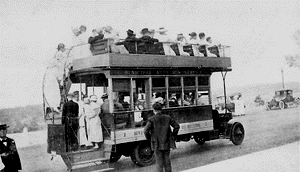Suburban Gardens: Recreation and Amusement
Recreation was a part of life that Wellstonians – even their early country forerunners – never overlooked.
Already the era of large summer gardens, the 1890s and early 1900s took on even more fun in Wellston with the further development of the electric railroad, including the Narrow Gauge Railway which was later renamed Suburban Railway. Indeed, as the City of St. Louis website notes, “It was a common transit business practice to operate summer gardens as a traffic generator for the car lines.”
There had always been in St. Louis small beer gardens with music and other entertainment, but now the street railway companies built large establishments, veritable Coney Islands in their many amusement attractions. They also presented excellent light opera performances. Such a place was Suburban Garden just north of Wellston. It continued to attract great throngs each summer until finally, it could no longer withstand the competition of the automobile, the radio, and the municipal opera.
Leo B. Painter, owner of the Model Printing Company, recalled in a 1946 interview, “Families used to go to the picnic grounds there of Sundays. Before the coming of the electric streetcar lines a horse car did a rushing business carting picnickers out to the two amusement places.” The groves were divided into lots, sold and streets cut through them in the early 1900s.
As Rinkel’s Grove and Offenstein’s Grove decreased in popularity, other recreation areas took their place. Wabash Lake proved to be a frequent destination, as did the Maxwelton Race Track.
The Old Suburban Gardens remained a favorite attraction. “That was where the Hodiamont and City Limits turned around at,” Wellston native Arthur Landsbury remembered. “They had a loop there. They had a big garden there. They had plays and vaudeville.”
Next.
